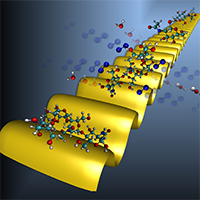 A ‘travelling’ DC wave (yellow) was used to separate charged glycans in the presence of a nitrogen drift gas, based on their shape. While smaller structures (ions) will be “carried” by the wave and have high mobility, larger ions of lower mobility will “roll over” the wave and take longer to move from one end of the mobility cell to the other. Ions of the same mass but different shape can therefore be separated by ion mobility mass spectrometry
A ‘travelling’ DC wave (yellow) was used to separate charged glycans in the presence of a nitrogen drift gas, based on their shape. While smaller structures (ions) will be “carried” by the wave and have high mobility, larger ions of lower mobility will “roll over” the wave and take longer to move from one end of the mobility cell to the other. Ions of the same mass but different shape can therefore be separated by ion mobility mass spectrometry
Dr Claire Eyers from the University of Liverpool’s Institute of Integrative Biology, and Professor Sabine Flitsch from the University of Manchester, and colleagues have developed a new strategy for determining the structure of complex sugars (also called glycans) using a combination of ion mobility spectrometry and mass spectrometry.
Like DNA and protein polymers, glycans are complex biomolecules which are information rich, playing key roles in infection and fertility, and their precise structures can be used as markers to identify different disease states.
In their work, published this week in the prestigious journal Nature Chemistry, Eyers and her co-workers demonstrate how ion-mobility mass spectrometry (IM-MS) can be used to separate glycans of identical mass but containing subtle differences in chemical structure, based on extremely small changes in their three-dimensional conformation.
Furthermore, by breaking apart the glycans by collision with an inert gas inside the IM-MS instrument, they were able to determine the chemical sequence of a series of short polysaccharides (di- and tri-saccharides) by virtue of determining both their mass and cross-sectional area.
This important study highlights the potential of IM-MS to overcome a major limitation currently associated with glycomic and glycoproteomic analysis and represents a new strategy for sequencing complex oligosaccharides which will enable scientists to better decode their biological function.
The full paper can be read on the Nature Chemistry website.
